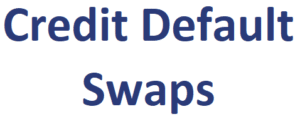Credit Default Swap
A credit default swap (CDS) is a contract between two parties in which one party buys protection from another party against losses from the default of a borrower. On this page, we describe default swaps as well as related index credit default swaps. We also briefly discuss credit events that could trigger the payout of a CDS.
CDS features and terms
A credit default swap (CDS) is essentially an insurance contract. If a credit event occurs, the credit protection buyer gets compensated by the credit protection seller. To obtain this coverage, the protection buyer pays the seller a premium called the CDS spread. The protection seller is taking on (i.e., long) credit risk, while the protection buyer is short credit risk. Note that a CDS does not provide protection against market-wide interest rate risk. A CDS only insures against credit risk. The contract is written on a face value of protection called the notional principal.
Even though the CDS spread should be based on the underlying credit risk of the reference obligation, standardization in the market has led to a fixed coupon on CDS products:
- 1% for investment grade securities
- 5% for high-yield securities
Hence, the coupon rate on the CDS and the actual credit spread may be different. The present value of the difference between the standardised coupon and the credit spread on the reference obligation is paid upfront by one of the parties to the contract.
For a protection buyer, a CDS has some of the characteristics of a put option. When the underlying performs poorly, the holder of the put option has a right to exercise the option.
The International Swaps and Derivatives Association (ISDA), the unofficial governing body of the industry, publishes standardised contract terms and conventions to facilitate smooth functioning of the CDS market.
Single-name CDS
In the case of a single-name CDS, the reference obligation is the fixed-income security on which the swap is written, usually a senior unsecured obligation (senior CDS). The issuer of the reference obligation is called the reference entity. The CDS pays off not only when the reference entity defaults on the reference obligation but also when the reference entity defaults on any other issue that is ranked pari passu or higher.
The CDS payoff is based on the market value of the cheapest-to-deliver bond that has the same seniority as the reference obligation.
Index CDS
An index CDS covers multiple issuers, allowing market participants to take on an exposure to the credit risk of several companies simultaneously in the same way that stock indexes allow investors to take on an equity exposure to several companies at once. In this case, the protection for each issuer is equal (i.e., equally-weighted) and the total notional principal is the sum of the protection on all the issuers.
The pricing of an index CDS is dependent on the correlation of default among the entities in the index. The higher the correlation of default among the index constituents, the higher the spread on the index CDS.
Credit events
A default is defined as the occurrence of a credit event. Common types of credit events specified in CDS agreements include bankruptcy, failure to pay, and restructuring:
- Bankruptcy: a bankruptcy protection filing allows the defaulting party to work with creditors under the supervision of the court so as to avoid a full liquidation
- Failure to pay: occurs when the issuer misses a scheduled coupon or principal payment without filing for formal bankruptcy
- Restructuring: occurs when the issuer forces its creditors to accept terms that are different than those specified in the original issue. Restructuring is less common in the US.
A 15-member group of the ISDA called the Determinations committee (DC) declares when a credit event has occurred. A supermajority vote (at least 12) is required for a credit event to be declared.
Summary
We discussed how credit default swaps work.

